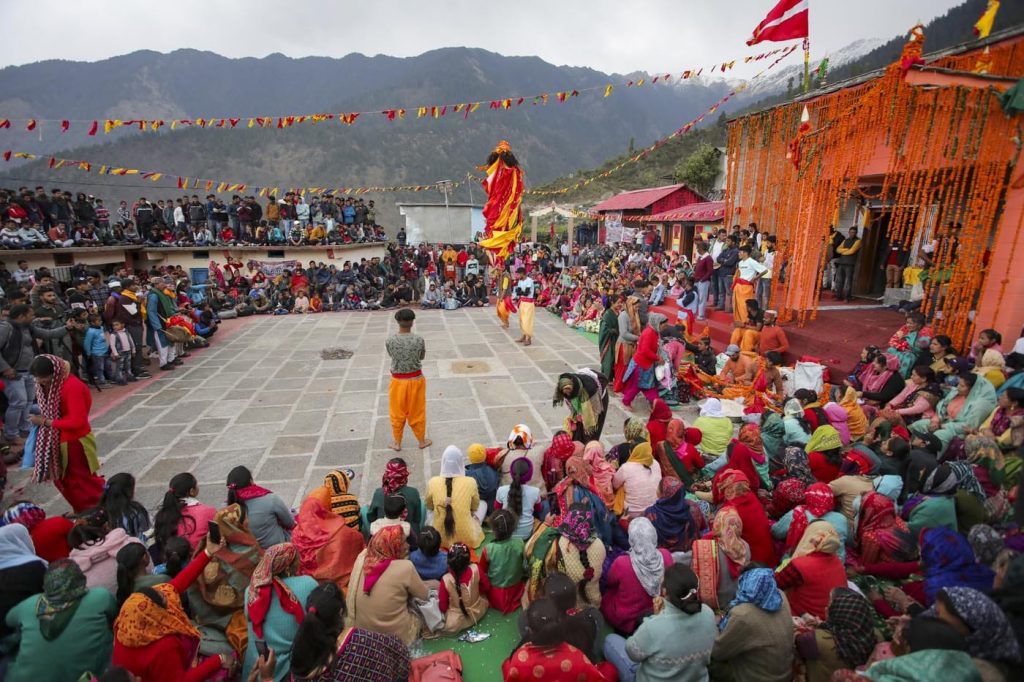Perhaps the most ancient portrayal of the epic is celebrated yearly by the villages of Saloor-Dungra, high in the Himalayan foothills above Haridwar
By Dev Raj Agarwal, Dehra Dun, India
All photos: devraj agarwal
The annual festival of bhumiyal Devta, a powerful local Deity some say is a form of Siva, has been celebrated from time immemorial for one fortnight, starting April 13th or 14th, in the adjacent villages of Saloor-Dungra, Uttarakhand. Popularly known as Ramman, it combines the spring procession of Bhumiyal Devta with rituals, pujas, unique mask dances, singing and group dances, simple episodes from Ramayana and performances of swang (“imitation” or “disguise”), a tradition of the region’s folk theater. The Ramayana performances are unique in that local boys silently portray the various characters, dancing slowly to the beat of drums, with no dialogue. In the background, jagar singers narrate the dances in the local dialect. Jagar, from Sanskrit jaga meaning “to wake,” is a unique tradition to the Uttarakhand area. As the name implies, its objective is to get the Deities’ attention and ask for blessings or boons.
The name Ramman is derived from the epic, but the tradition of mask dances is much older. It is believed that the Ramayana episodes were incorporated after the arrival of Adi Shankaracharya to the Himalayas. Although his direct influence would be difficult to substantiate, he stayed four years in nearby Badrinath in the late eighth century and would have narrated the stories of Ram, Krishna and the Gods to the local people.
According to American scholar Paula Richman, author of Many Ramayanas, the Ramman in this remote corner of the Himalayas is India’s oldest documented Ramleela tradition. In 2009, authenticating its antiquity and originality, UNESCO inscribed Ramman on the Representative List of the Intangible Cultural Heritage of Humanity. The festival is now sponsored by the Indira Gandhi National Center for Performing Arts. Other villages in the area have similar celebrations, but none as elaborate as Ramman in Saloor-Dungra.
Dr. D. R. Purohit, a retired professor of English literature from Garhwal University and an authority on Himalayan folk drama, and Dr. Kushal Singh Bhandari, a teacher by profession, have been laboriously striving to revive this dying art of folk theater, mask dances and jagar singing. In particular they are seeking to document the jagar songs, as most of the jagar artists have passed away, and many an unwritten song is now gone with them forever.

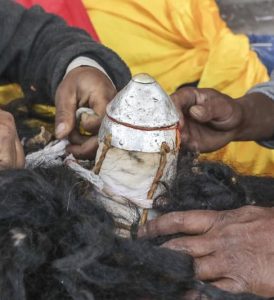
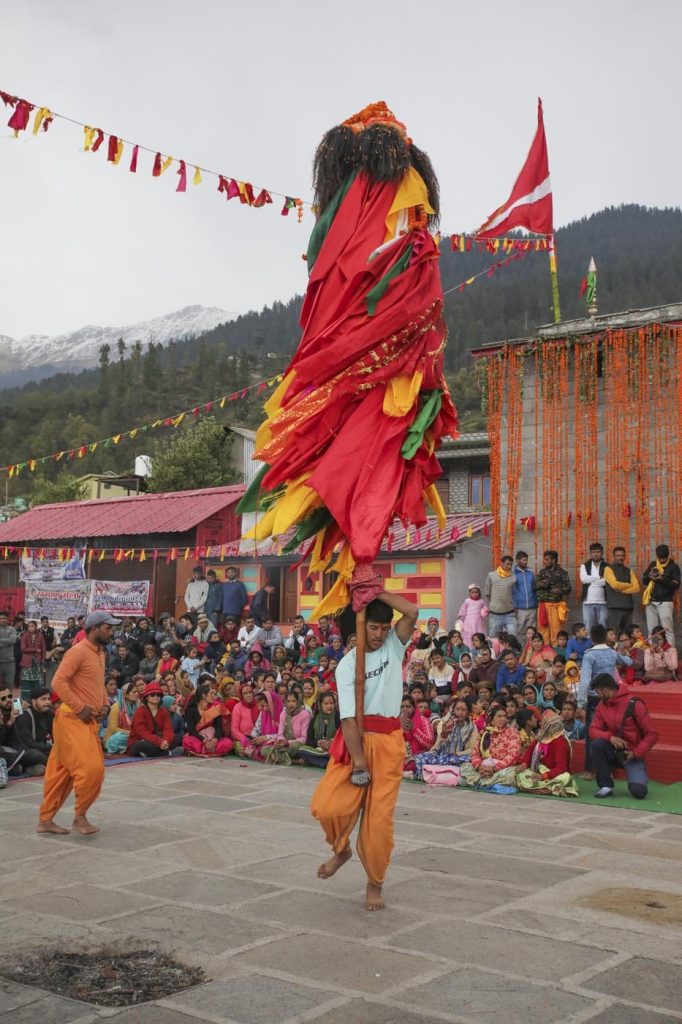
Understanding the Festival
The entire festival revolves around Bhumiyal Devta, the Supreme Deity of the region. He is the guardian of the land, of people, crops and animals, of good health and prosperity. “All other Deities—Rama, Arjuna, Krishna—surrender their powers to Bhumiyal,” says Dr. Purohit. “Nothing moves without the involvement of Bhumiyal in villages of this little-known part of the western Himalayas.”
The start of the month of Vaisakhi, April 13 (or rarely the 14th, as happened this year), is the first day of the annual procession of Bhumiyal, the day when He visits His temple after a year-long stay in one of the village homes. Theater, drama, mask dances, singing and group dances all begin on the day of Vaisakhi. Bhumiyal remains at the temple until the 27th, one fortnight, until this concluding day of Ramman after which the entire festival is named. Then He is taken to another villager’s home until the following April. This tradition is common in the area, according to Dr. Purohit, with more than 500 such Deities in Uttarakhand.
For the Negis family the past year of hosting the Deity has been full of austerities and strong discipline for the men of the household. Each morning one of them arose very early to perform the daily puja, lighting the ghee lamp, offering incense and food to the Deity. Today, Vaisakhi, is the day to say goodbye. Drummers and trumpeters have arrived in their courtyard. The loud music calls the entire village to join the procession escorting Bhumiyal to the temple, and people of all ages start pouring in.
Examples from the temple’s mask collection:
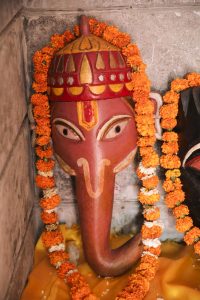
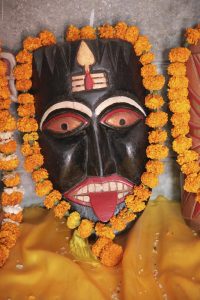
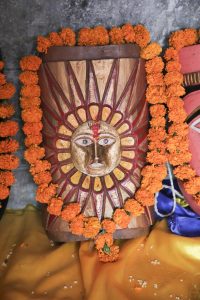
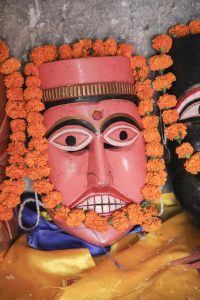
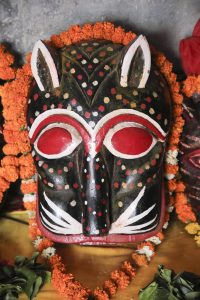
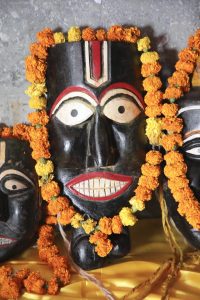
Three among the crowd are special. Called pashwas, they are men who in the course of the event become possessed by the Deity, answering and speaking prophecies at different times. One is connected to Bhumiyal, one to Nandadevi (Bhumiyal’s sister) and one to Bhagawati, all local Deities.
Now, as the final pujas are performed in the house, preparing the Deity for His journey, the three pashwas go into trance. They shiver and tremble as their faces turn red with eyes open wide. Without a blink, looking into the void, they dance with the music, while devotees anticipate with folded hands to hear what they will say. One can feel the power of the Deity in the charged atmosphere.
In the home, Bhumiyal is worshiped in the form of a small silver kalasa or pot, along with large bundles of hair and silk cloth. When brought out for the festival, the kalasa is affixed to the top of a tall pole, with the hair and fabric attached to the sides. This is paraded to the temple with cries of “Jai Bhumiyal Devta” and offerings of barley sprouts. Each morning and evening at the temple, a young man will bring the pole out and dance with it. This continues until the thirteenth day of Vaisakhi.
The Bhumiyal temple in Saloor remains the center of activities for two fortnights, from April 13th to the portrayals from the Ramayana on the 27th. The temple priests are in full-time attendance. Each day there is a race among the young boys to bathe, dress in yellow dhoti and dance with the Deity, accompanied by local drummers and horn players.


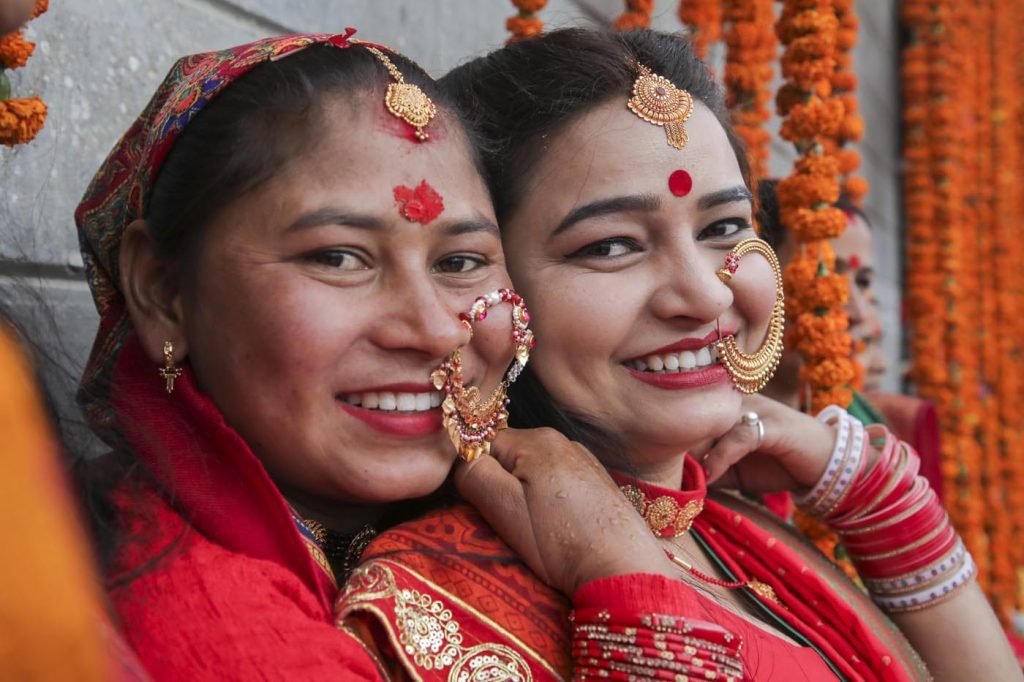
Late in the evening, village families gather in the temple courtyard to enjoy the beautiful jagar songs and watch the dances and small plays, many of which employ the temple’s masks portraying Gods and sages such as Surya, Durga and Narada. Made of birch wood, the oversized masks, most too big to fit on the face, are tied on with scarves and strings. “We call our masks pattar, and worship them as representative of the Gods. They are charged with divine energy,” explains Bhandari.
In one dance, the creation of the Earth is narrated. In another, sage Narada is implored to go to the different planes of existence and request the Gods and Goddesses to bless the village. There is a dance for Radha, consort of Krishna, and another for the Pandavas.
Some of the dances are for light-hearted entertainment. Almost every evening there is a dance involving Mawar and Mawaini, a shepherd couple who face many dangers as they pass through dense forests on their long journey to Saloor-Dungra. In one of these, a drummer asks the Mawars about their well-being, the journey and their herd. Amused by the lifestyle of this distant land, the Mawar respond by teasing the audience on their dress, language and food. Other dances involve a trader couple, Baniya and Baniyayin, portraying their trials as their families travel on foot with servants and caravans of goods.
The Day of Ramman
Finally the main day arrives. The temple of Bhumiyal wears a festive look, and the sounds of trumpet and drum make it difficult to hear anything else! Young boys wait their turn to take charge of the Deity and dance around the courtyard. The women especially are dressed in their best clothes and jewelry. Activities begin around 1:15pm and end at 6pm, cut short this year by heavy rain and wind.
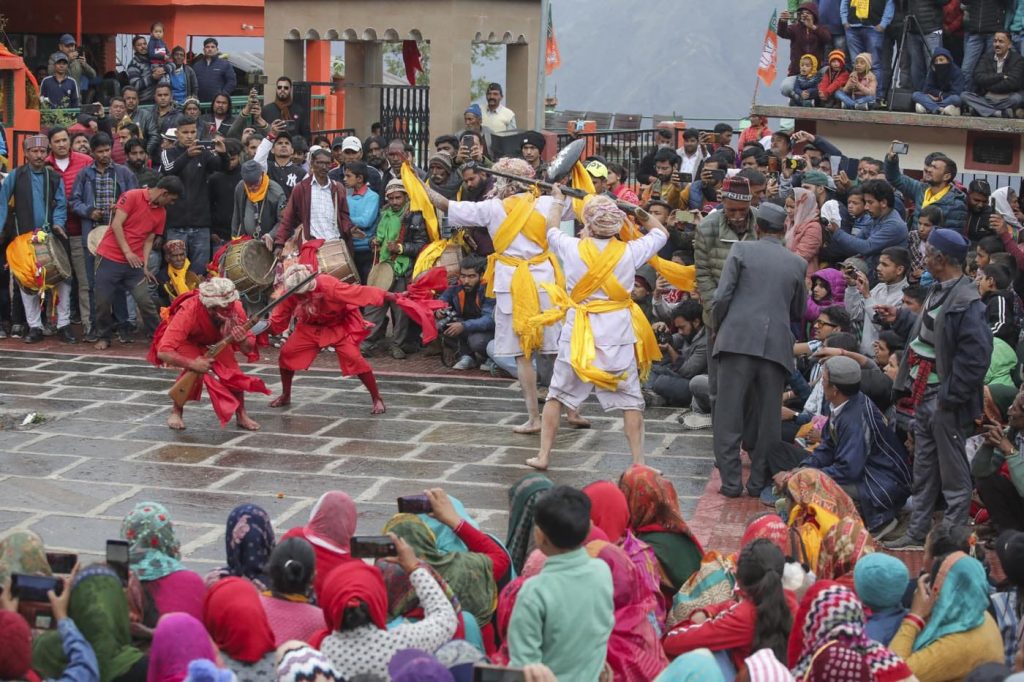

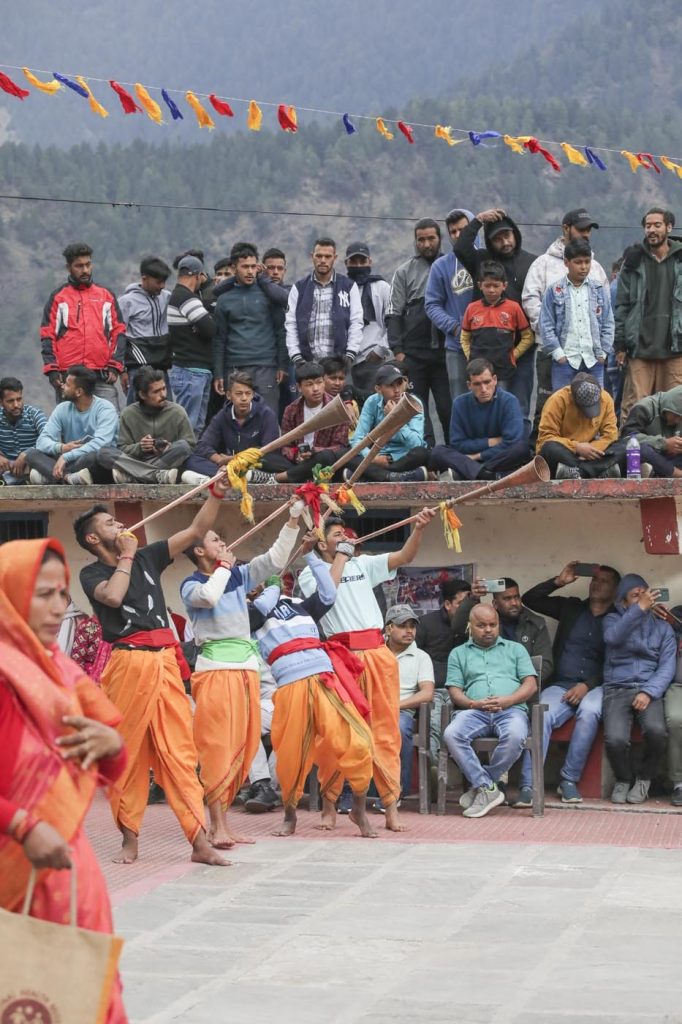
The dances and accompanying jagar songs for the tales of Rama are organized around 18 talas—drum patterns of classical Indian music that date back to the Vedas. The singers, who have come from the distant villages of Bhalgaon and Subhain, are unfortunately nearly the last of their kind. During the first seven talas, the story of Lord Rama is told. The eighth is dedicated to Parvati, the ninth to Sita’s svayamvara, the ceremony in which she chooses Rama as her husband. On the tenth tala, Lord Rama, Sita and Lakshmana dance together.
Other dances are interspersed, each with its own tala. In one, the herders Mawar and Mawarin appear again, dancing slowly to the beat as they dramatize being attacked by a tiger in the forest. Suddenly there is a change in the drumming, signaling that the Deity Bhumiyal has come again. A young man steps out onto the plaza with the Deity’s pole. He struggles to maintain his balance as his quick steps follow the beating of the drums, turning and twisting the long shaft in his hands in quick succession. Its divine energy makes it difficult for him to control.
Following the herders, the trader couple Baniya and Baniyayin reappear, joined by a group of dancers in strange costumes. They make fun of the audience, picking out one after another to lightheartedly imitate and mock. Some of the dancers portray thieves, who try to divert the attention of the rich trader, and the audience, in order to rob him!
Next is the Maal dance, depicting the repelling of Gorkha invaders at a place known as Rapwal Gwaad around 1815. It is a intense presentation as two fighters in red and two in white enter the arena from opposite sides, armed with guns, kukri swords and shields. Stepping to the beat of the drums, they move forward and backward from each other brandishing their weapons, to the enjoyment of the cheering crowd.
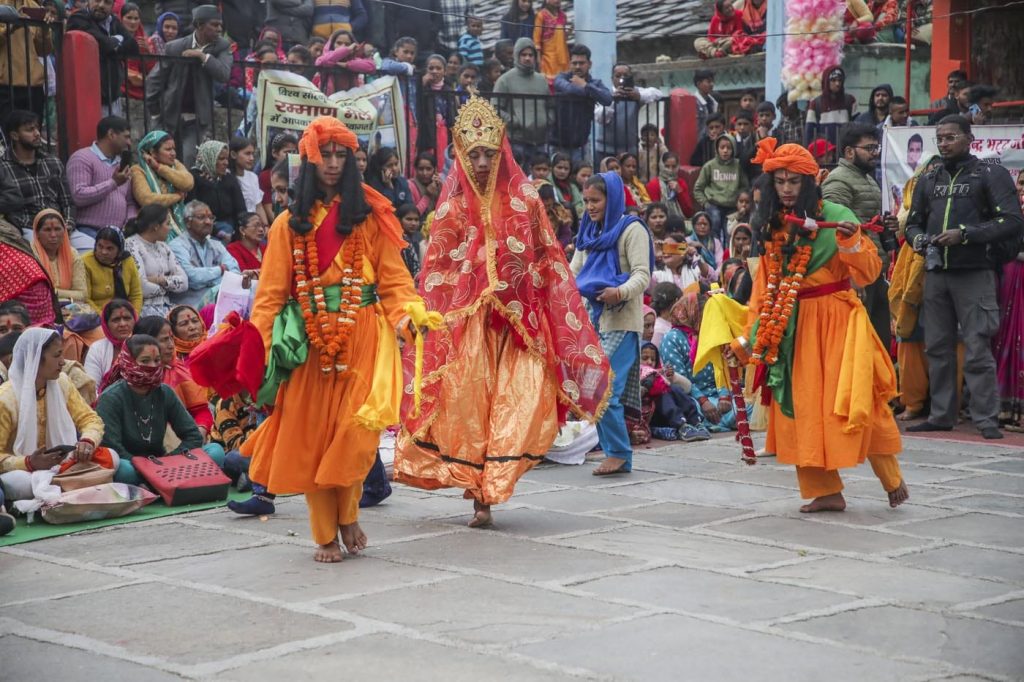
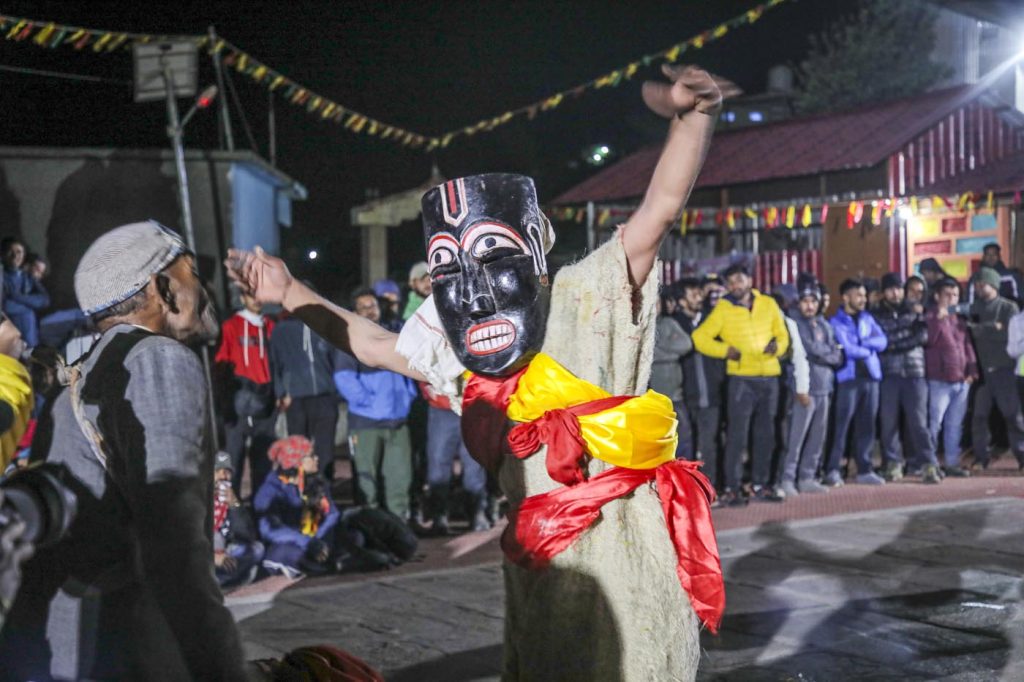
On the sixteenth tala, Rama kills the golden deer and departs, fatefully entrusting the security of Sita to his brother Lakshmana. On the seventeenth, Rama dances while holding the mask of the head of the slain deer. In his absence, Sita has been abducted by Ravana. The dance continues with Hanuman flying to Lanka to find Sita, and in the process burning large parts of the island. All this takes place in haste because of the unexpected rainstorm.
The accession of Rama to the throne takes place on the eighteenth tala. Brahmin priests bless Rama, Sita and Lakshmana by putting tilak on their foreheads and offering worship with lamps. The dancers signal the final end by repeating eighteen times with the audience a plea to the Gods for peace and prosperity in the villages. The ancient plea is “Raunlya Paunlya Hey Bharati Bhai.” It literally means, “O Brothers Raunlya and Paunlya of Bharat!” It was explained to me that by addressing Raunlya and Paunlya, two oxen, all the Deities are addressed. The chanting is followed by a long list of favors sought, spoken out by those present.
With the approach of dusk, the silver kalasa pot, the vessel of Bhumiyal, is removed from the pole and brought inside the temple. In the courtyard a new dance begins, the story of Narasimha, the half-man, half-lion incarnation of Vishnu who saved the devotee Prahlada. It is quite hypnotic. Even the ongoing heavy rains and chilly winds do not dampen the dancers’ spirits, held in trance by the cosmic energy of the extraordinarily large and heavy mask of Narasimha.
At the end of the dance, the silver kalasa, the hair and silk fabrics of Bhumiyal are once again brought to the courtyard and reattached to the pole. One of the pashwas appears in front of Bhumiyal, quickly goes into trance and behaves like the Deity Himself. He bathes himself by emptying vessels of water on his head, thrusts the dagger blades of the Deity into his belly, hitting them hard with a stone, and then makes prophesies about the wellbeing of the people and the village at large.
At the end, the Deity’s kalasa, cloth and hair are packed in bamboo baskets and taken in procession to His new home for the coming year. “All celebrations in our villages take place because of Bhumiyal, our Supreme Deity, the protector of our land and cattle,” states Bhagat Singh Rawat of Dungri. “Ramman is an ancestral, cultural, religious and social program which binds people together in a close society since time immemorial.”

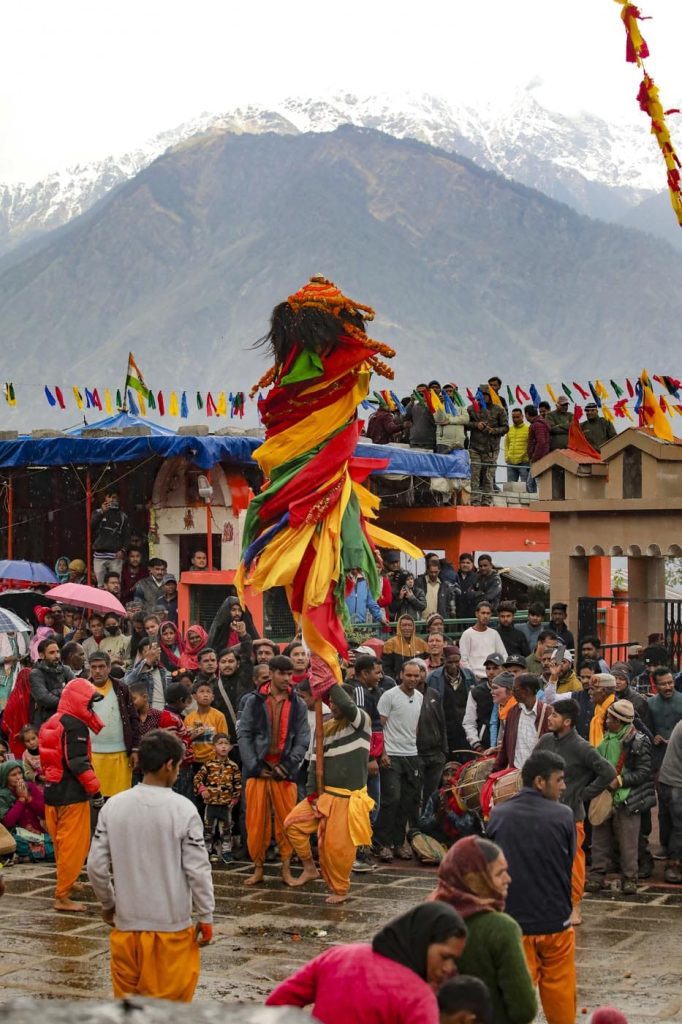
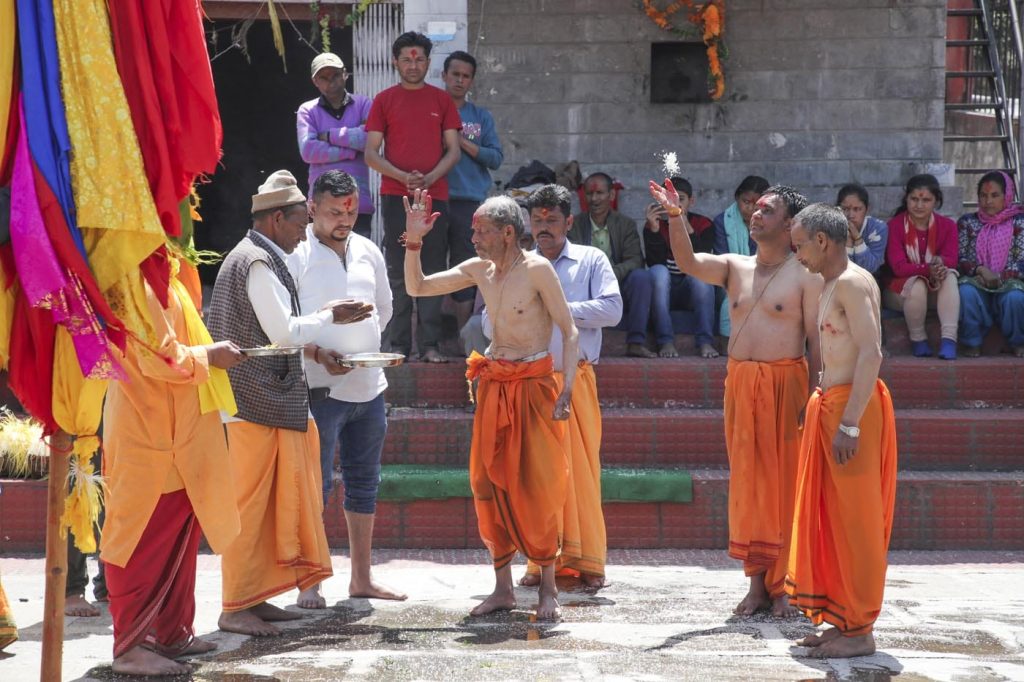
Conclusion
Dr. Purohit has been one of the key figures behind the preservation of the festival in Saloor-Dungra. In his view, “We have a great future for our folk arts if we document them properly.” He explains such traditions come in three parts: ritual, history and narrative. If one part is lost, there is no future for the tradition. We must emphasize the maintenance of parampara, teaching lineages, and the learning of the Vedas, Puranas and shastras—and this should happen without consideration for caste. “It can only be done by constructing more universities, gurukulams and colleges. We must create more avenues for students of Sanskrit and the shastras to pursue a career upon completion of their studies. It is equally important to conserve the dying art forms such as the Ramman masks and document the songs, such as the jagars, and the various stories. I don’t think we need publicity, documentation is more important.”
Ramman has been provided an international platform ever since it received the recognition of UNESCO. More and more people, including Westerners, are curious to see for themselves the extraordinary masks and the unique way the Ramleela is performed here. Saloor and Dungra are still small villages, with no hotels or home-stays yet. To visit Saloor, one has to travel by road about 150 miles from Rishikesh to Joshimath, where there are hotels. Saloor is situated in a side valley, about five miles from Joshimath.
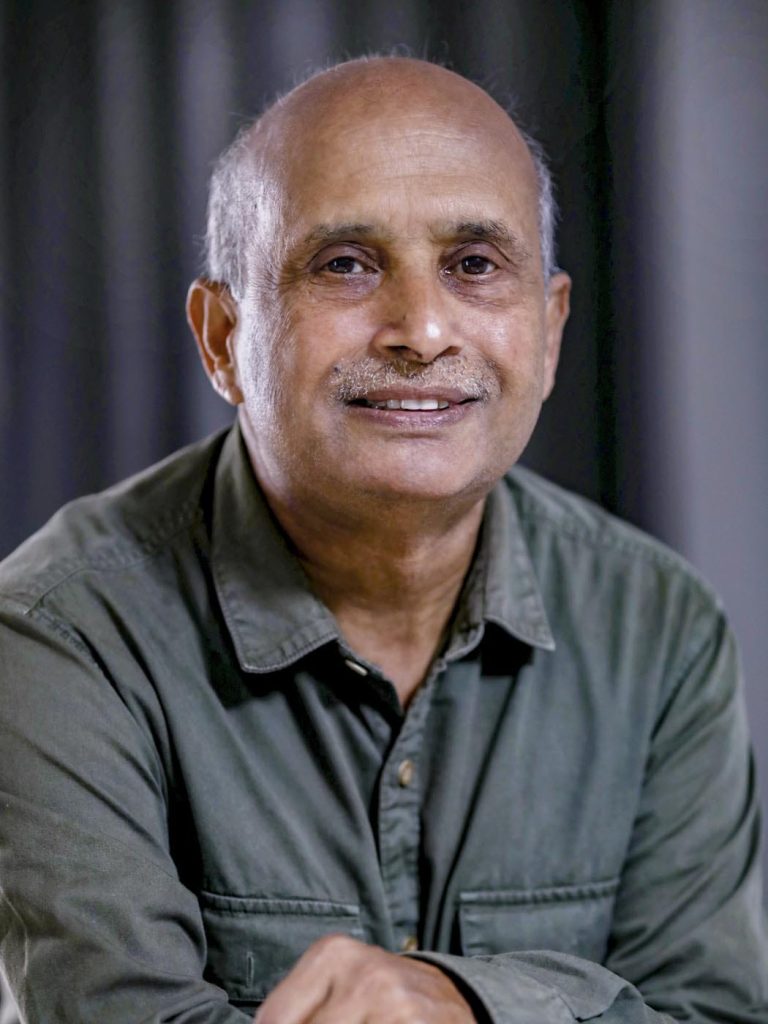
About the Author
Dev Raj Agarwal of Dehradun, India, is a photographer who loves to capture Bharat’s immense diversity of people, cultures and nature, especially in the Himalayas. He is retired from the Ministry of Environment and Forests, Botanical Survey of India. Email: devrajagarwal@hotmail.com
